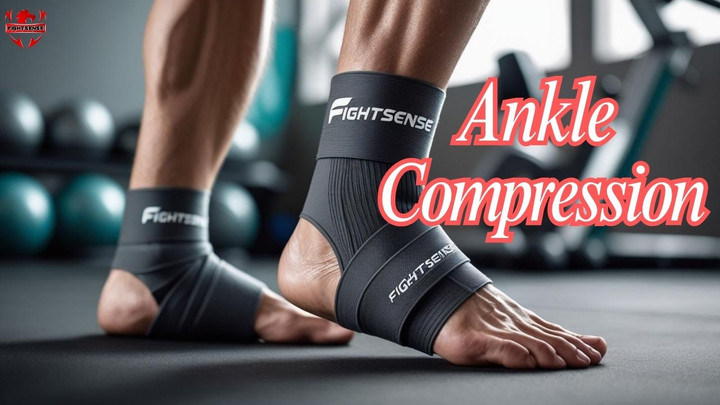Ankle Compression for 2025: What You Should Know
28th Jul 2025
Whether you’ve twisted your ankle during a run or are dealing with ongoing joint pain, using the right ankle compression method can help manage swelling, reduce discomfort, and speed up recovery. It’s not just for athletes—anyone can benefit. In this blog, we’ll cover what it does, how it works, and when it’s most helpful, especially for sprains and swelling.
Keynotes
- Ankle compression reduces swelling, pain, and supports recovery.
- Use compression sleeves or wraps after a sprain for faster healing.
- It’s effective not just for injuries, but also for general ankle support.
- Ensure proper fit and avoid over-tightening the wrap or sleeve.
- Always consult a doctor if swelling worsens or persists.
What is Ankle Compression?
Ankle compression is a technique used to support the ankle joint by applying gentle, steady pressure using a compression sleeve or bandage. It helps control swelling, reduces discomfort, and promotes healing after injuries like sprains. Athletes, patients recovering from surgery, or people with swollen ankles often use it. It’s also used to prevent further damage while allowing for safe movement.
How it works:
- Improves blood flow to speed up recovery
- Reduces fluid buildup and swelling
- Supports ligaments and soft tissues
- Stabilizes the joint and reduces risk of re-injury
Sprained Ankle Compression: Why It Matters
A sprained ankle compression treatment is often one of the first steps in the R.I.C.E. method—Rest, Ice, Compression, and Elevation. When you sprain your ankle, the small ligaments that support it get stretched or torn. This causes swelling, pain, and sometimes bruising.
Compression helps by:
- Minimizing swelling around the injured ligaments.
- Preventing excess fluid from accumulating in the area.
- Offering external support to avoid further strain.
- Use a snug (not tight) compression wrap
- Loosen it if you feel tingling or numbness
- Wear during the day for support
- Remove at night unless your doctor advises otherwise
Ankle Compression for Swelling: When to Use It
Not only can sports injuries make your ankle swell. It can also happen after a lengthy time of standing, after surgery, or because of long-term problems like arthritis. Using compression on your ankles to reduce swelling is a sensible and efficient technique to ease pain and help the healing process.
Benefits of using it for swelling:
- Stops fluid from building up (oedema) around the joint
- Reduces stiffness and pressure in the ankle
- Helps joints and muscles work more smoothly
- Helps lower swelling so you can move better
- Helps with daily comfort, no matter if you're busy or resting
You can use either compression sleeves or elastic bandages; just pick the one that feels best. Fightsense ankle compression sleeves and other similar products provide breathable, long-lasting support that can be used every day. Also, try to raise your foot while you rest to help blood flow and healing.
How to Use It Safely?
- Choose the right fit: Too loose won't help, too tight can restrict blood flow.
- Clean and dry: Always apply compression on clean, dry skin to avoid irritation.
- Check regularly: Watch for signs like numbness or cold toes.
- Combine with other treatments: Use it along with ice, rest, and elevation for better results.
When Not to Use Ankle Compression
While ankle compression is generally safe and helpful, there are certain conditions where it should be avoided. Using it without caution in these cases could make things worse.
Avoid it if you have:
- Severe fractures or open wounds – Compression can interfere with healing and worsen bleeding or tissue damage
- Poor circulation issues – Conditions like peripheral artery disease (PAD) may be aggravated by added pressure
- Signs of a blood clot – Swelling with redness, warmth, or tenderness might indicate a clot, which needs immediate medical attention
- Severe nerve damage or neuropathy – Reduced sensation can prevent you from feeling if the wrap is too tight
According to doctors and medical professionals, always speak with a healthcare provider before starting compression treatment, especially if you have an underlying condition. Proper diagnosis and guidance ensure you’re using ankle compression safely and effectively.
Conclusion
This simple yet useful method helps control injuries and lessen swelling around the joint. It can help you heal faster and feel better every day, whether you're treating a sprain or general inflammation. Just make sure to use it correctly, pay attention to how you're feeling, and relax and move gently when you need to.
Consistency is important; applying the correct support on a regular basis might stop more damage from happening. Always consult a doctor right away if your symptoms don't go away or get worse.
Disclaimer
This blog is for informational purposes only. It is not a substitute for professional medical advice, diagnosis, or treatment. Always seek advice from your physician or qualified healthcare provider with any questions about a medical condition.

